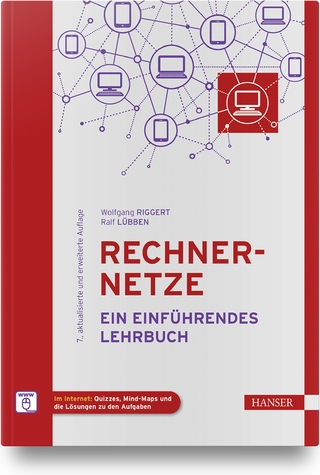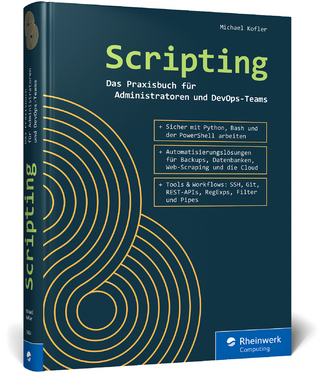
Internet of Things
ISTE Ltd and John Wiley & Sons Inc (Verlag)
978-1-78630-151-2 (ISBN)
Numerous issues associated with these new technological and digital transformations in a "hyperconnected" world, as well as the impact of the massive influx of connected objects, are discussed. The crucial questions of potential intrusion into the private lives of users as well that of security are then studied.
Nasreddine BouhaÏ, Paris 8 University, France. Imad Saleh, Paris 8 University, France.
Introduction xi
Chapter 1 The IoT: Intrusive or Indispensable Objects? 1
Nasreddine BOUHAÏ
1.1 Introduction 1
1.2 The age of miniaturization and technological progress 2
1.3 The history of a digital ecosystem 3
1.4 Internet of Things, which definition? 5
1.5 The security of connected objects: the risks and the challenges 5
1.6 Protocols, standards and compatibility: toward a technological convergence 6
1.6.1 The origins of some norms and standards 7
1.7 Humanity, intelligence and technologies 9
1.7.1 Crowdfunding as an aid to innovation 9
1.7.2 Participatory environmental sensors and citizens 10
1.7.3 When digital art goes into connected mode 12
1.7.4 Home automation for a connected and communicating habitat 13
1.7.5 Connected objects, a step toward the enhanced human 15
1.8 Conclusion 17
1.9 Bibliography 18
Chapter 2 The Ecosystem of the Internet of Things 21
Ioan ROXIN and Aymeric BOUCHEREAU
2.1 Introduction 21
2.2 Context, convergences and definition 22
2.2.1 The Internet Toaster or the first connected object in history 22
2.2.2 From the Internet of computers… 23
2.2.3 … to the Internet of objects 38
2.3 Conclusion 47
2.4 Bibliography 48
Chapter 3 Introduction to the Technologies of the Ecosystem of the Internet of Things 51
Ioan ROXIN and Aymeric BOUCHEREAU
3.1 Architectures recommended by the Internet Architecture Board 52
3.1.1 Communication between objects 52
3.1.2 Communication from objects to the Cloud 53
3.1.3 Communication from objects to a gateway 54
3.1.4 From objects to back-end data sharing 55
3.2 Three-tier architecture 56
3.2.1 Layered architecture 57
3.3 Steps and technologies in the ecosystem of the IoT 59
3.3.1 Identifying 62
3.3.2 Capturing 64
3.3.3 Connecting 65
3.3.4 Integrating 68
3.3.5 Networking 79
3.4 Opportunities and threats in the IoT ecosystem 82
3.4.1 Opportunities 82
3.4.2 Threats 87
3.5 Conclusion 90
3.6 Bibliography 91
Chapter 4 Toward a Methodology of IoT-a: Embedded Agents for the Internet of Things 97
Valérie RENAULT and Florent CARLIER
4.1 Introduction 97
4.2 Multi-agent simulations, ambient intelligence and the Internet of Things 98
4.3 Triskell3S: an architecture of embedded agent-oriented inter-actions 102
4.4 Transposition of the formalization of agent-oriented interaction to connected objects 103
4.5 Formalization 106
4.6 Experimentation and perspectives 110
4.7 Bibliography 112
Chapter 5 The Visualization of Information of the Internet of Things 117
Adilson Luiz PINTO, Audilio GONZALES-AGUILAR, Moisés LIMA DUTRA, Alexandre RIBAS SEMELER, Marta DENISCZWICZ and Carole CLOSEL
5.1 Introduction 117
5.2 Internet of Things 120
5.3 InfoVis and DataVis in the Internet of Things 123
5.3.1 Visual analytics in the context of the Internet of Things 125
5.4 Analytical visualization in the context of the Internet of Things 130
5.5 Conclusion: the relevance of the use of visualization in the Internet of Things 134
5.6 Bibliography 135
Chapter 6 The Quantified Self and Mobile Health Applications: From Information and Communication Sciences to Social Innovation by Design 139
Marie-Julie CATOIR-BRISSON
6.1 Introduction 139
6.2 The evolution of interfaces and connected objects toward anthropotechnics 141
6.2.1 From e-health to the “Quantified Self” 141
6.2.2 Anthropotechnics and the information ecosystem of Chris Dancy 143
6.2.3 Connected objects as the heirs of ubiquitous computing 145
6.3 Factitive dimension and value system at the heart of Chris Dancy’s relationship with his information technology 146
6.3.1 The progressive development of the figure of the enhanced human in socio-digital networks 146
6.3.2 Information design and data-visualization: the case of Fitbit and Existence 147
6.3.3 Animism and anthropomorphism: a particular relationship to connected objects 148
6.4 Critical perspective and avenues for reflection for reconsidering the use of connected objects and mobile applications in the field of health 153
6.4.1 Ethical and social issues related to data governance 153
6.4.2 The doctor-patient relationship transformed by connected objects and mobile health applications 156
6.4.3 The necessity of considering the point of view of doctors and healthcare professionals 158
6.4.4 Envisaging other paths for m-health technologies based on the anthropology of communication and social innovation by design 160
6.5 Conclusion 164
6.6 Bibliography 165
Chapter 7 Tweets from Fukushima: Connected Sensors and Social Media for Dissemination after a Nuclear Accident 169
Antonin SEGAULT, Frederico TAJARIOL and Ioan ROXIN
7.1 Introduction 169
7.2 The IoT: a shift in the development of digital services 170
7.3 Social media and the dissemination of information during a catastrophe 172
7.4 Context of the study 174
7.5 Goals of our study 177
7.6 Methodology 177
7.7 Results 178
7.7.1 Comprehensive overview 179
7.7.2 Popularity of bots 179
7.7.3 Completeness of the shared measurements 180
7.7.4 Source of the measurements shared 181
7.8 Discussions 182
7.9 Conclusions 183
7.10 Acknowledgements 184
7.11 Bibliography 184
Chapter 8 Connected Objects: Transparency Back in Play 189
Florent DI BARTOLO
8.1 Introduction 189
8.2 Sensitive objects 190
8.3 The myth of transparency 195
8.4 Transparency of interfaces and opacity of processes 200
8.5 Conclusion 207
8.6 Bibliography 208
Chapter 9 Status of the Body within the Internet of Things: Revolution or Evolution? 211
Evelyne LOMBARDO and Christophe GUION
9.1 Introduction 211
9.2 Presence and absence of the body in the field of sports and e-health 212
9.3 The traceability of the body or the integration of data by a digital coach 212
9.4 The IoT creates a flow of information around the body: a present, readable and traceable cluster 213
9.5 The body in interaction: sharing Clouds to inform the informational environment 215
9.6 Clouds, persistence and trust: a mapped body without the right to be forgotten 216
9.7 The body, an object communicating between hyper-control and non-control 217
9.8 Conclusion 218
9.9 Bibliography 219
List of Authors 221
Index 223
| Erscheinungsdatum | 13.10.2017 |
|---|---|
| Verlagsort | London |
| Sprache | englisch |
| Maße | 162 x 238 mm |
| Gewicht | 522 g |
| Themenwelt | Mathematik / Informatik ► Informatik ► Netzwerke |
| Mathematik / Informatik ► Informatik ► Web / Internet | |
| Technik ► Elektrotechnik / Energietechnik | |
| ISBN-10 | 1-78630-151-2 / 1786301512 |
| ISBN-13 | 978-1-78630-151-2 / 9781786301512 |
| Zustand | Neuware |
| Haben Sie eine Frage zum Produkt? |
aus dem Bereich


